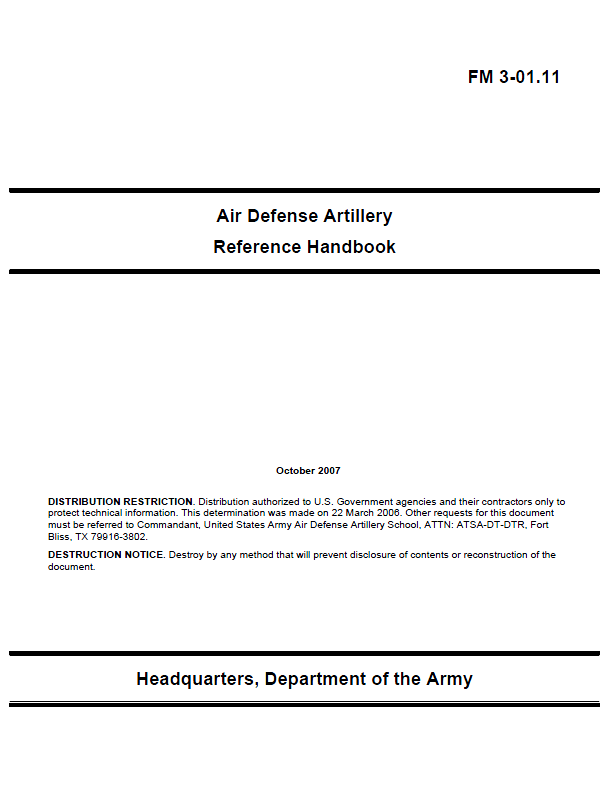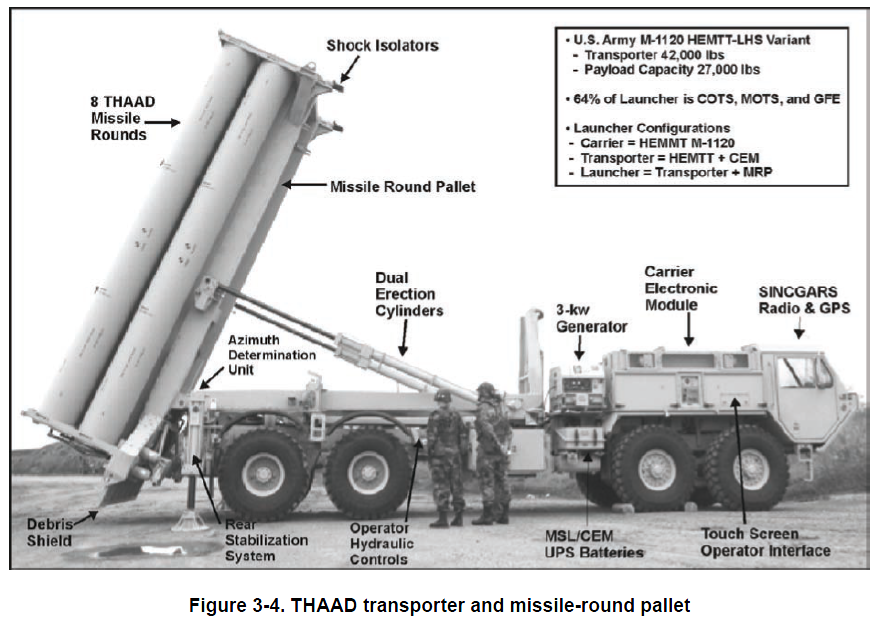The following document was originally posted to Scribd by an unknown individual in October 2010.
FM 3-01.11 Air Defense Artillery Reference Handbook
- 104 pages
- Distribution authorized to U.S. Government agencies and their contractors only toprotect technical information.
- October 2007
The purpose of this field manual (FM) is to familiarize personnel with air defense artillery (ADA) operations and weapon systems and their roles in air and missile defense (AMD). This publication is intended for personnel serving in the following positions:
- Staff positions requiring general knowledge of ADA systems and operations.
- Instructor positions in service schools and the Reserve Officer Training Corps.
- Members of advisory elements and groups assigned to missions in foreign countries.
- Advisory positions in reserve component forces.
- Command and leadership positions in special operations force units.
- Executive positions and advisory positions that require knowledge of air defense subjects.
Readers are reminded that weapon systems and operations are continually changing. Publications such as interactive electronic technical manuals, table(s) of organization and equipment (TOE), and mission training plans provide more detailed information on specific subjects. Many of these sources are referred to in appropriate sections of this FM.
AIR DEFENSE ARTILLERY MISSION
The mission of U.S. Army ADA is to protect the force and selected geopolitical assets from aerial attack, missile attack, and surveillance using AMD mission sets. The four mission sets are—
- Provide AMD.
- Contribute to situational awareness/situational understanding (SA/SU).
- Contribute to Airspace Command and Control (AC2).
- Contribute to operational protection.
AIR AND MISSILE DEFENSE MISSION
Army ADA forces, fighting interdependently with other elements of the joint, interagency, and multinational (JIM) team at strategic, operational, and tactical levels, provide critical air and missile defense. They also contribute to SA and SU, airspace management, and operational force protection to deter or defeat enemy aerial threats, protect the force and high-value assets, enable freedom to maneuver, and contribute to victory. The four elements of the AMD mission statement—Dominate, Enable, Exploit, and Protect—have specific meanings within the context of Army ADA. These elements are imperative to focus on ADA transformation for the future. The Dominate-Enable-Exploit-Protect cycle contributes synergistically to support JIM operations. Army ADA transformation will address capability gaps as part of a larger joint AMD transformation effort. ADA commanders allocate active and reserve air defense (AD) component assets based on the supported commander’s priorities. The mission is designed to include protection of critical assets, installations, and facilities along with the joint and multinational forces when required.
GEOPOLITICAL ASSETS
Geopolitical assets are nonmilitary assets that U.S., allied, or host nation civil authorities nominate for AMD protection. These assets can be political, religious, ethnic, historical, or territorial in nature. Since protection of geopolitical assets may not directly support military operations, the integration of geopolitical assets into the AMD priorities list must be accomplished at the highest levels.
THREAT
The evolving AMD threat will take on new characteristics. The major threat to deployed U.S. forces will continue to be that of regional powers as they seek to dominate their respective regions. Adversaries will continue to closely observe emerging U.S. capabilities in an effort to identify and exploit weaknesses using asymmetric approaches. Chemical, biological, radiological, and nuclear (CBRN) weapons proliferation and their delivery means (particularly ballistic and cruise missiles [BMs and CMs]), stealth capabilities, and the employment of unmanned aircraft systems (UASs) will improve their military forces and the asymmetric options available to them when facing the U.S. and its allies and coalition partners.
Fundamental capabilities that adversaries may pursue to counter U.S. strengths include, but are not limited to, weapons of mass destruction, unmanned intelligence, surveillance, and reconnaissance (ISR) target acquisition platforms, UASs, large numbers of inexpensive rockets, low-observable cruise missiles, and information warfare. Some states may rely on asymmetric capabilities as a substitute for, or complement to, large conventional forces. Regional competition reinforces the perceived need to acquire unmanned systems that provide high operational effectiveness for nominal cost.
AIR AND MISSILE DEFENSE OPERATIONS
AMD operations are inherently joint operations, multicomponent, and embody Army doctrine. ADA forces are versatile, agile, and fight throughout the depth of the theater of operations. Through aggressive planning and carefully coordinated execution of the plan, the ADA assets allow the commander at any level to seize and maintain the initiative. Commanders integrate AMD operations into campaigns fought at the operational and tactical engagement levels.
Successful AMD operations are the key to generating and sustaining combat power in force projection operations. The ADA contribution to friendly efforts to counter threat reconnaissance, surveillance, and target acquisition (RSTA) and identification efforts establishes a greater emphasis on current Army ADA capabilities. Both active and reserve components must synergistically combine with AD assets of other services to defeat the multifaceted threat. The Army AD forces participate in operations at all levels of war.
This FM describes ADA weapon systems currently in the force. Short-range air defense (SHORAD) weapons are employed in support of maneuver forces. They defend personnel and assets against attack by enemy aerial platforms. They are also employed to defend air bases, forces, key installation, and other vital assets. SHORAD weapon systems include Avenger and Stinger. The Patriot system is deployed to defend theater and corps commanders’ assets. Patriot provides protection against airborne threats from very low to very high altitudes. The terminal high-altitude area defense (THAAD) system is also deployed to defend theater and corps commander’s assets. THAAD serves as a high-altitude defense against BMs. It is capable of detecting and intercepting BM threats in and above the atmosphere.
Also described in this FM are the Sentinel radar sensor system, the air defense and airspace management (ADAM) cell, and the training devices and aerial targets used to train Soldiers to promote skills, knowledge, and expertise required to maintain their proficiency with the above-mentioned ADA systems.
…


